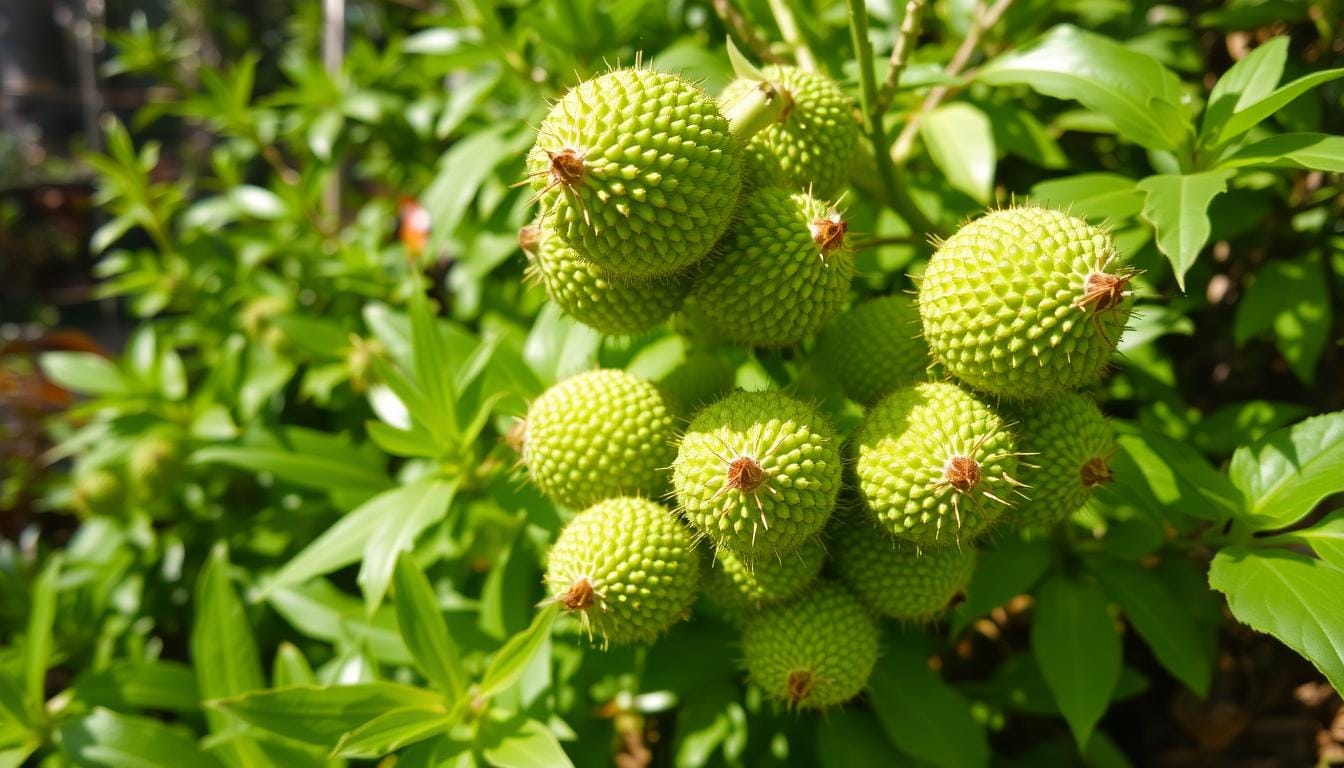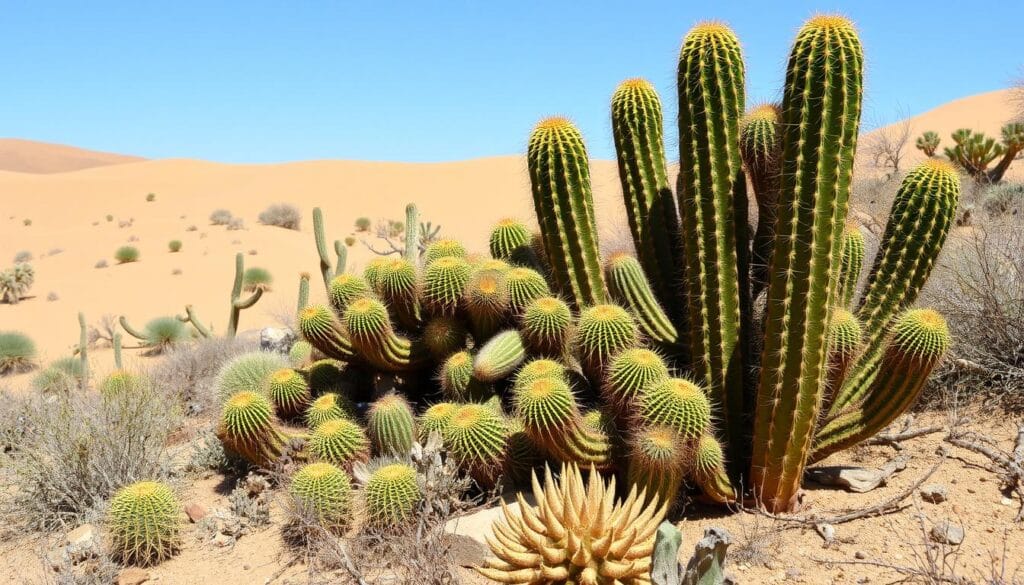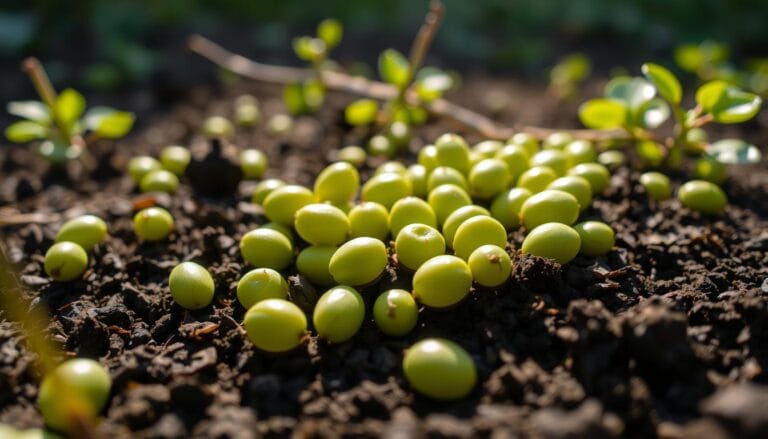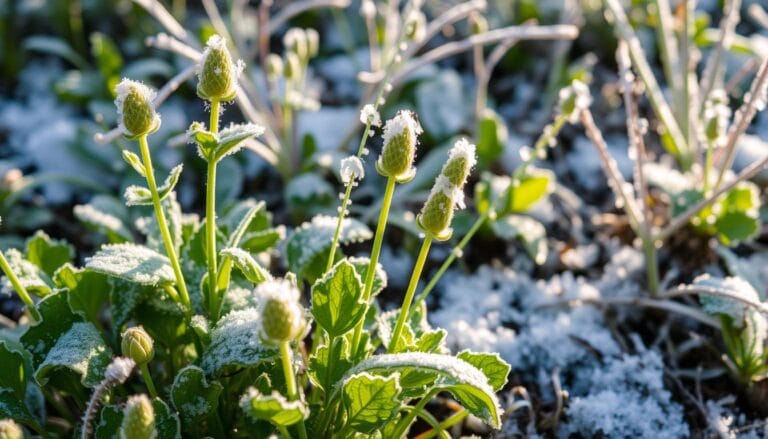Plants with prickly green pods

As a passionate gardener, finding a plant with a unique twist is exciting. A prickly, spiny pod adds texture and intrigue to any garden. These plants, from buckeye trees to sweet gum, bring a special touch to our surroundings.
These plants are not just beautiful. They show nature’s clever ways to protect itself. Their spiky pods keep animals from eating the seeds. It’s a fascinating way plants and nature work together.
Exploring plants with prickly green pods, spiny vegetation, thorny shrubs, and barbed foliage is thrilling. I want to share my excitement with you. Let’s discover the stories of these plants and their place in nature together.
Table of Contents
Understanding Plants with Prickly Green Pods
Some plants have prickly green pods to protect their seeds. These spiny plants have evolved to keep predators away and save water. They also help control temperature, which is key for survival.
What Makes Pods Prickly
The spines on these pods come from the plant’s inner system. They provide support and keep predators out. The size and shape of these spines vary by plant type.
For example, trees like the buckeye, chestnut, and sweet gum have big, spiky pods. These pods can grow up to several inches wide.
The Role of Protective Spines
The spines on pods do more than just protect. They also help keep the seeds cool or warm. This is important for the seeds to grow.
These spines also help save water. This keeps the seeds moist and ready to grow.
Natural Defense Mechanisms
Prickly pods are a clever way for plants to protect their seeds. They also help spread seeds by sticking to animals. This lets seeds travel to new places.
“The prickly nature of these pods serves multiple purposes. They act as a physical deterrent, discouraging animals from consuming the seeds and damaging the plant.”
| Plant Species | Prickly Pod Characteristics | Ecological Benefits |
|---|---|---|
| Buckeye (Aesculus) | Spiky green balls, 2-4 inches in diameter | Seed dispersal, temperature regulation, herbivore deterrence |
| Chestnut (Castanea) | Burr-like, prickly green pods surrounding the nuts | Seed protection, temperature control, water conservation |
| Sweet Gum (Liquidambar styraciflua) | Spiky green balls, 1-2 inches in diameter | Seed dispersal, wildlife attraction, creative applications |
It’s important to understand why plants have prickly pods. Their spiny features help them survive and spread. These plants have clever ways to protect themselves and their seeds.
Common Trees with Spiky Seed Pods
Many trees stand out for their spiky seed pods. The Ohio buckeye (Aesculus glabra) and common horsechestnut (Aesculus hippocastanum) have prickly capsules that open in fall. Inside, you’ll find nuts.
The American chestnut (Castanea dentata) and Chinese chestnut (Castanea mollissima) have green fruits that split when ripe. These fruits are shaped like balls.
The sweet gum (Liquidambar styraciflua) is another tree with unique features. It has spiky green fruits, about the size of a golf ball. These fruits turn brown and fall, adding interest to landscapes.
| Tree | Spiky Seed Pods | Noteworthy Features |
|---|---|---|
| Ohio Buckeye (Aesculus glabra) | Prickly capsules that split open in fall | Typically small to medium-sized, ranging from 20 to 40 feet high |
| Common Horsechestnut (Aesculus hippocastanum) | Prickly capsules that split open in fall | Can grow up to 128 feet once fully mature |
| American Chestnut (Castanea dentata) | Green ball-shaped fruits that split when ripe | Produces a great source of fiber, vitamins, and minerals |
| Chinese Chestnut (Castanea mollissima) | Green ball-shaped fruits that split when ripe | Commonly used for landscaping across Europe |
| Sweet Gum (Liquidambar styraciflua) | Spiky green fruits about the size of a golf ball | Known for its glossy leaves and vibrant fall colors |
These trees add beauty and serve wildlife. They help make environments more diverse.
The honey locust (Gleditsia triacanthos) is another tree with spiky pods. It can grow up to 100 feet tall and live for 125 years. Its leaves are compound, with leaflets up to 3.6 cm long.
The tree’s fruit is a flat pod that matures in early autumn. It can hold up to twenty dark brown oval seeds, about 2 cm long. The honey locust’s thorns can grow up to 20 cm, protecting the tree.
“These trees with their distinctive spiky pods not only add visual interest to landscapes but also provide valuable ecological benefits, serving as food sources for wildlife and enhancing the overall biodiversity of the environment.”
Identifying Features of Prickly Pod Plants
Exploring prickly pod plants is a fascinating adventure. These tough cactus, succulents, and desert flora have unique leaf patterns, change with the seasons, and grow pods in interesting ways. These traits make them stand out from other plants.
Leaf Patterns and Structures
The leaves of prickly pod plants are quite varied. For example, the Ohio buckeye has compound leaves with five oval-shaped leaflets. The horsechestnut has seven leaflets. The sweet gum tree has glossy green leaves with five points, similar to the sugar maple.
Seasonal Changes
As seasons change, prickly pod plants go through amazing transformations. In fall, their leaves turn vibrant colors, making landscapes more interesting. These changes help identify these desert flora.
Pod Development Stages
The pods of prickly pod plants grow from soft, green to hard, woody. Watching them develop can teach us about the plant’s life and help us identify it.
Learning about the unique features of prickly pod plants deepens our appreciation for them. These succulents play a special role in nature.
Native American Species with Protective Pods
The native landscapes of North America are filled with diverse plants. These plants have unique defense mechanisms, like prickly green pods. They are vital to local ecosystems and hold deep cultural and historical value for Native American communities.
The American chestnut (Castanea dentata) was once a key tree in eastern U.S. forests. Sadly, a fungal blight nearly wiped it out. Yet, its spiky green burrs with edible nuts were crucial for many Native American tribes. The sweet gum (Liquidambar styraciflua) is another native plant with protective pods. It’s a shade tree with distinctive leaves and spiky fruits, offering shelter and nesting sites for wildlife.
These plants have developed prickly pods to protect themselves from herbivores. This helps maintain biodiversity in their native habitats. Native American communities have long valued these species for food, medicine, and more. By preserving these plants, we honor the past and support the health of our ecosystems.
| Native American Plant Species with Prickly Pods | Key Features | Ecological Significance |
|---|---|---|
| American Chestnut (Castanea dentata) | Tall, dominant tree with spiny green burrs containing edible nuts | Once a major food source for Native Americans, now threatened by fungal blight |
| Sweet Gum (Liquidambar styraciflua) | Shade tree with distinctive star-shaped leaves and spiky, woody fruits | Provides shelter and nesting sites for wildlife in native habitats |
| Buffalo Burr (Solanum rostratum) | Native North American plant with yellow flowers and spiny fruits | Distributed globally as a weed, disliked universally for its prickly nature |
| Sandbur (Cenchrus longispinus) | Native American plant found predominantly in trampled areas on sandy soils | Challenging for grazing animals due to its spiny burrs |
By preserving these plants with prickly green pods, we honor North America’s indigenous heritage. We also support the ecological balance of our natural landscapes.

Ornamental Plants with Decorative Spiky Pods
Not just cacti and succulents have striking seed pods. Many ornamental plants have spiky pods that add texture and interest to gardens. Love-in-a-mist (Nigella damascena) has balloon-shaped capsules, while poppies (Papaver spp.) have unique paper mâché-like pods. These plants are perfect for gardeners who want to add a unique touch to their outdoor spaces.
Garden Design Applications
Spiky pod plants fit into many garden styles, from cottage to modern. Their shapes make them great as focal points or accents. They can be used in borders, beds, or as standalone plants to make a statement.
Seasonal Interest
These plants are interesting all season, not just when they bloom. As flowers fade, the pods become the main attraction. Some plants, like false indigo (Baptisia australis), keep their pods interesting into winter.
Aesthetic Value
These plants add beauty to gardens beyond their function. Their shapes and textures bring drama and intrigue. They work well with many styles and colors, making any garden more artistic.
“Incorporating plants with decorative spiky pods into your garden design can add a unique and visually striking element that sets your outdoor space apart from the ordinary.”
Wildlife Interaction and Ecological Impact
Plants with prickly green pods are key in ecosystems. They offer food, shelter, and homes for many animals. For example, the sweet gum tree’s dried pods are homes for birds and food for small mammals in winter.
Milkweed, a plant with prickly pods, is vital for wildlife. Its pods are a main food for monarch butterfly larvae. This makes milkweed crucial for the monarch’s life cycle.
Some plants, like the spotted touch-me-not, burst their pods when touched. This helps spread their seeds. It also gives birds and small mammals a chance to find food.
These prickly pod plants do more than just spread seeds. They also provide homes and food for many animals. This helps keep the desert ecosystem balanced and strong.
“The interconnectedness of plants and wildlife is a crucial aspect of a healthy, thriving ecosystem. By understanding the multifaceted roles of plants with prickly green pods, we can better appreciate the intricate web of life in the desert.”
Adding these plants to gardens and landscapes is good for both looks and wildlife. It helps create a diverse, thriving environment that many animals can enjoy.
| Wildlife Interaction | Impact |
|---|---|
| Deer browsing | Severe damage or plant death |
| Rabbit feeding | Stunted growth or plant death |
| Squirrel damage | Reduced foliage and seed production |
| Bird pecking | Impacts on plant growth and seed integrity |
| Rodent gnawing | Damage to stems and roots |
| Groundhog chewing | Decimation of young plants |
| Pollinator activity | Enhanced seed production and garden sustainability |
| Predatory insect presence | Reduced need for chemical interventions |
By studying how plants with prickly green pods interact with desert flora, we learn a lot. We see how these plants help keep the ecosystem balanced and healthy.

Cultivation and Care Requirements
Understanding the needs of plants with prickly green pods is key. Most love full sun, enjoying warm, bright spots. But, some like the spotted touch-me-not (Asparagaceae) do well in partial shade.
Different Asparagaceae and thorny shrubs have different soil needs. Some need sandy, well-draining soil, while others are more flexible. Making sure the soil is right is vital for their health.
Watering Needs
Watering needs vary too. Many can handle drought once they’re settled, needing water only now and then. Others need more water, especially when they’re growing. It’s important to check the soil and water as needed to avoid too much or too little water.
Maintenance Tips
- Pruning: Regular pruning helps keep these plants looking good and the right size.
- Pod Removal: It’s good to pick up fallen pods to avoid damage.
- Growth Inhibitors: Sometimes, using growth inhibitors helps control how many pods grow.
Knowing how to care for plants with prickly green pods helps gardeners and landscapers. This way, they can make these plants thrive and look great in any garden.
| Species | Hardiness Zones | Mature Size |
|---|---|---|
| Opuntia humifusa (Eastern Prickly Pear) | Zones 4-9 | Up to 12 inches tall and wide |
| Opuntia microdasys ‘Albaspina’ | Zones 9-10 | 2 feet tall |
| Opuntia aurea (Golden Prickly Pear) | Zones 5-9 | 9 inches to 2 feet tall |
| Opuntia fragilis (Brittle Prickly Pear) | Zones 4-11 | 6 inches tall, 9 inches wide |
| Opuntia macrohiza (Plains Prickly Pear) | Zones 3-9 | 6 to 12 inches tall |
Practical Uses and Applications
Plants with barbed foliage and spiny vegetation are more than just pretty. For example, angelica (Angelica archangelica) is used in cooking and medicine. The prickly parts of some plants can be used in crafts, flower arrangements, or as mulch.
Teasel (Dipsacus sativus) has been used in making textiles. This shows how useful these plants can be. They add beauty and function to gardens and landscapes.
Some plants with prickly pods are mainly grown for looks. But, finding new uses for them can make your garden more interesting. These plants can be used in cooking, medicine, or crafts. This makes gardening more rewarding and lets you enjoy nature in different ways.
FAQ
What are the distinctive features of plants with prickly green pods?
What is the purpose of the prickly pods?
What are some common trees known for their spiky seed pods?
How can you identify plants with prickly pods?
What are some examples of native American plant species with protective pods?
How can ornamental plants with spiky pods be used in gardens?
What are the ecological impacts of plants with prickly green pods?
What are the care requirements for cultivating plants with prickly green pods?
What are the practical uses of plants with prickly green pods?
Source Links
- 19 Plants with Ornamental Seed Pods – https://www.epicgardening.com/ornamental-seed-pods/
- Common Plants – Petroglyph National Monument (U.S. National Park Service) – https://www.nps.gov/petr/learn/nature/plants.htm
- How to Identify Each and Every Type of Tree With Spiky Balls – https://www.bhg.com/gardening/trees-shrubs-vines/trees/what-kind-of-tree-produces-spiked-round-balls/
- Observations from a Pollinators Garden – Part 4:Seed-Saving – https://www.burlingtongardencenter.com/btown-dirt-blog/observations-from-a-pollinators-garden-part-4seed-saving
- Honey locust – https://en.wikipedia.org/wiki/Honey_locust
- Sycamore Trees: Ultimate Guide (6 Types, Seeds, Leaves, Identification) – https://8billiontrees.com/trees/sycamore-tree/
- Trees With Spiky Balls: Best Guide With Prickly Fruits ! – https://treecuttinglife.com/trees-with-spiky-balls/
- Wild Herbs of the Mediterranean Spring: Prickly Alkanet – https://www.greenprophet.com/2024/03/wild-herbs-of-the-mediterranean-spring-prickly-alkanet/
- Prickly Pear Cactus Propagation From Cuttings and Seeds – https://www.epicgardening.com/prickly-pear-cactus-propagation/
- Scotch Broom (Cytisus scoparius) – Long Island Invasive Species Management Area (LIISMA) – https://liisma.org/scotch-broom-cytisus-scoparius/
- Western Nebraskan Plants Easily Seen At Cedar Point Biological Station – http://khkeeler.blogspot.com/2024/09/western-nebraskan-plants-easily-seen-at.html
- Achenes and Samaras and Nuts, Oh My! – Alliance for the Chesapeake Bay – https://www.allianceforthebay.org/2024/08/achenes-and-samaras-and-nuts-oh-my/
- Grow Gorgeous Moonflower with This Simple Planting Guide – https://www.bhg.com/gardening/plant-dictionary/annual/moonflower/
- Everything You Need to Know About Yucca Plants – Yuccas Care Guide – https://planetdesert.com/blogs/news/yucca-types-care-guide?srsltid=AfmBOoqxLvIkKmSzhtcIGHS9lKqnq8a6VtQGbb-4lR4BC3lOCr_nQocN
- Ultimate Guide to What’s Eating Your Castor Bean 🐛 – https://greg.app/what-eats-castor-bean/
- introduced plants – awkward botany – https://awkwardbotany.com/tag/introduced-plants/
- How do invasive predators and their native prey respond to prescribed fire? – https://pmc.ncbi.nlm.nih.gov/articles/PMC11112300/
- How to Grow and Care for Prickly Pear – https://www.thespruce.com/grow-prickly-pear-cactus-inside-1902533
- Plants 101: Succulent Care | Plant Care Articles & How-Tos – https://www.thesill.com/blogs/plants-101/plants-101-succulents?srsltid=AfmBOop5lO-BO_WeARCuzqFAFlQKDdkjY-sI1vlCx_gd49Gp1xKUaAHK
- What Is Prickly Ash? – https://www.verywellhealth.com/the-benefits-of-prickly-ash-4684452
- Prickly pear – https://www.publications.qld.gov.au/ckan-publications-attachments-prod/resources/292be137-a5d5-44e5-8841-bb0ce0df8e5d/prickly-acacia.pdf?ETag=1d29445d65e7583e719c86e17b5e2ffd
- Got Milkweed? – https://www.johnson.k-state.edu/programs/lawn-garden/agent-articles-fact-sheets-and-more/agent-articles/perennials/got-milkweed.html
There are no reviews yet. Be the first one to write one.






